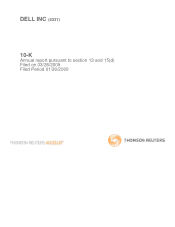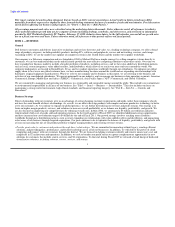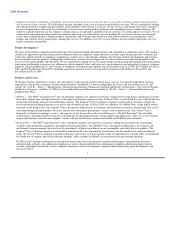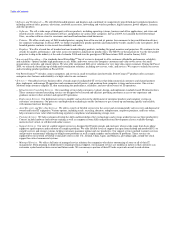Dell 2008 Annual Report Download - page 9
Download and view the complete annual report
Please find page 9 of the 2008 Dell annual report below. You can navigate through the pages in the report by either clicking on the pages listed below, or by using the keyword search tool below to find specific information within the annual report.
Table of Contents
Competition
We operate in an industry in which there are rapid technological advances in hardware, software, and service offerings and face on-going product
and price competition in all areas of our business from branded and generic competitors. We compete based on our ability to offer profitable and
competitive solutions to our customers that provide the most current and desired product features as well as customer service, quality, and reliability.
This is enabled by our direct relationships with customers, which allow us to recognize changing customer needs faster than other companies. This
connection with our customers allows us to best serve customer needs and offers us a competitive advantage.
According to IDC, we gained 0.2 points of share during calendar 2008 as our 11.1% growth in units outpaced the industry's overall worldwide
computer systems growth of 9.7%. Our gain in share was driven by a strong overall performance in the first half of Fiscal 2009 followed by a
decline in unit shipments in our commercial business in the second half of the year, which was partially offset by strength in our global consumer
business. Our commercial business's slower unit growth in the second half of Fiscal 2009 reflects our decision in an eroding demand environment to
selectively pursue unit growth opportunities while protecting profitability. During the second half of Fiscal 2009, the entire industry faced a
challenging IT end-user demand environment as current economic conditions influenced global customer spending behavior.
Technology companies grow by expanding product offerings and penetrating new geographies. To achieve this growth, companies innovate and will
also lower price. Our ability to maintain or gain share is predicated on our ability to be competitive on product features and functionality, geographic
penetration, and pricing. Additionally, our efforts to balance our mix of products and services to optimize profitability, liquidity, and growth may put
pressure on our industry unit share position in the short-term. At the end of Fiscal 2009, we remained the number one supplier of computer systems
in the U.S. and the number two supplier worldwide.
Manufacturing and Materials
We manufacture many of the products we sell and have manufacturing locations worldwide to service our global customer base. See "Part I —
Item 2 — Properties" for information about our manufacturing locations. In addition, we are continuing to expand our use of original design
manufacturing partnerships and manufacturing outsourcing relationships to generate cost efficiencies, deliver products faster, and better serve our
customers in certain segments and geographical areas.
Our manufacturing process consists of assembly, software installation, functional testing, and quality control. Testing and quality control processes
are also applied to components, parts, sub-assemblies, and systems obtained from third-party suppliers. Quality control is maintained through the
testing of components, sub-assemblies, and systems at various stages in the manufacturing process. Quality control also includes a burn-in period for
completed units after assembly, ongoing production reliability audits, failure tracking for early identification of production and component problems,
and information from customers obtained through services and support programs. We are certified worldwide by the International Standards
Organization to the requirements of ISO 9001: 2000. This certification includes our design, manufacture, and service of computer products in all of
our locations.
We purchase materials, supplies, product components, and products from a large number of vendors. In some cases, multiple sources of supply are
not available and we have to rely on single-source vendors. In other cases, we may establish a working relationship with a single source or a limited
number of sources if we believe it is advantageous due to performance, quality, support, delivery, capacity, or price considerations. This relationship
and dependency has not caused material disruptions in the past, and we believe that any disruption that may occur because of our dependency on
single- or limited-source vendors would not disproportionately disadvantage us relative to our competitors. See "Part I — Item 1A — Risk Factors"
for information about the risks associated with single- or limited-source suppliers.
We are actively reviewing all aspects of our facilities, logistics, supply chain, and manufacturing footprints. This review is focused on identifying
efficiencies and cost reduction opportunities and migration to a more variable cost manufacturing model, while maintaining a strong customer
experience. Examples of these actions include the closure of our desktop manufacturing facility in Austin, Texas, the sale of our call center in El
Salvador, the recent announcement of our migration and closure of manufacturing operations from our Limerick, Ireland facility to our Polish
facility and to original design manufacturers, and the sale of our customer contact center in the Philippines.
Patents, Trademarks, and Licenses
As of January 30, 2009, we held a worldwide portfolio of 2,253 patents and had an additional 2,514 patent applications pending. We also hold
licenses to use numerous third-party patents. To replace expiring patents, we obtain new patents through our ongoing research and
5






















